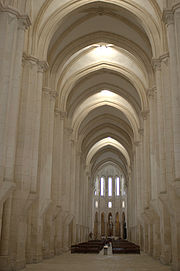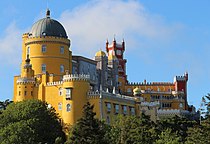Portuguese Gothic architecture
This article relies largely or entirely on a single source. (January 2021) |
Portuguese Gothic architecture is the architectural style prevalent in Portugal in the Late Middle Ages. As in other parts of Europe, Gothic style slowly replaced Romanesque architecture in the period between the late 12th and the 13th century. Between the late 15th and early 16th century, Gothic was replaced by Renaissance architecture through an intermediate style called Manueline.

Churches and monasteries
After the foundation of Alcobaça, the Gothic style was chiefly disseminated by
Many of the Romanesque cathedrals were modernised with Gothic elements. Thus, the Romanesque nave of
Several Gothic
In the early 15th century, the building of the
Another Gothic variant was the so-called Mudéjar-Gothic, which developed in Portugal towards the end of the 15th century, especially in the Alentejo region. The name Mudéjar refers to the influence of Islamic art in the Christian kingdoms of the Iberian Peninsula, especially in the Middle Ages. In the Alentejo and elsewhere, Mudéjar influence in several buildings is evident in the profile of windows and portals, often with horseshoe arches and a mullion, circular turrets with conical pinnacles, Islamic merlons, etc., as well as tile (azulejo) decoration. Examples include the portico of St Francis Church of Évora, the courtyard of the Sintra Royal Palace and several churches and palaces in Évora, Elvas, Arraiolos, Beja, etc. Múdejar eventually intermingled with the Manueline style in the early 16th century.
Castles and palaces
During the Gothic era, several castles had to be either built or reinforced, especially along the border with the
Starting in the 14th century, keep towers became larger and more sophisticated, with rib vaulting roofs and facilities like fireplaces. Keep towers with improved residential characteristics can be found in the castles of
Notable examples
-
Cloisters and church of theMonastery of Alcobaça
-
Cloisters ofOporto Cathedral(14th century)
-
Ambulatory of Lisbon Cathedral (14th century)
-
Transept and lantern-tower ofÉvora Cathedral(13th century)
-
Main façade of Silves Cathedral (15th century)
-
Cloisters ofÉvora Cathedral(14th century)
-
Mudéjar-Gothic: main façade of St Francis of Évora (late 15th century)
-
Leça do Balio Monastery, Matosinhos (14th century)
-
Castle of Ourém (15th century)
-
Gothic porch in Estremoz Castle
-
Municipality of Guimarães with Gothic gallery (early 16th century)
-
Star rib-vaulting of the Founder's Chapel of theMonastery of Batalha(15th century)
-
Sintra National Palace (15th-16th centuries)
-
Entrance towers of Penedono Castle (15th century)
-
Gothic bridge of Ponte de Lima
-
Portal of the Our Lady Convent inBeja(15th century)
See also
References
- ^ Martins, Ana Maria Tavares (2010). "Cistercians in Portugal: From Order to Congregation According to an Architectural Perspective" (PDF). University of Beira Interior.

















